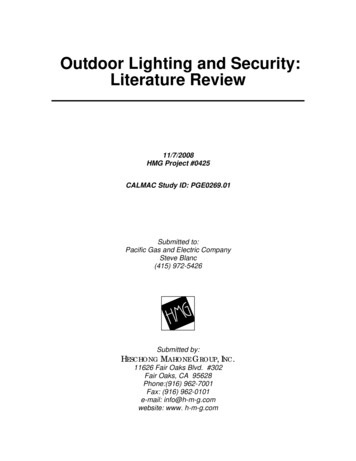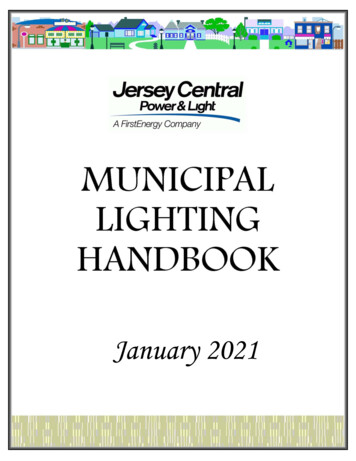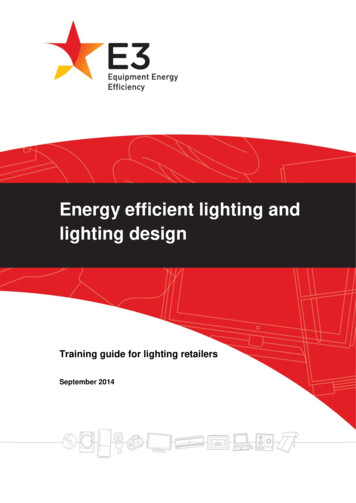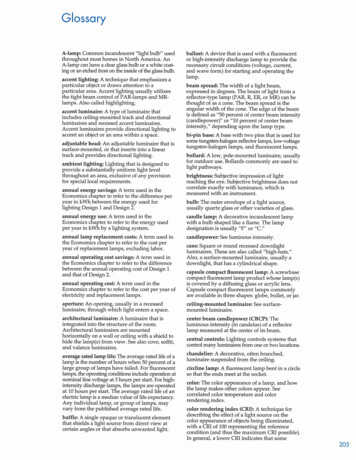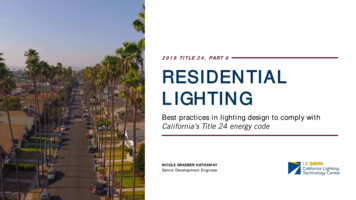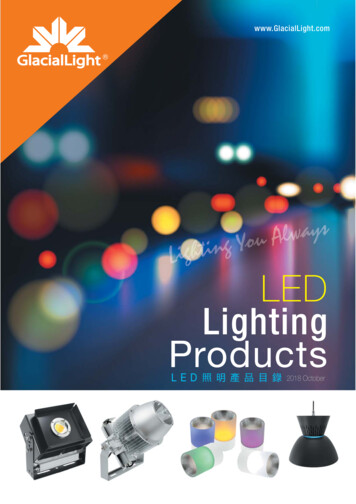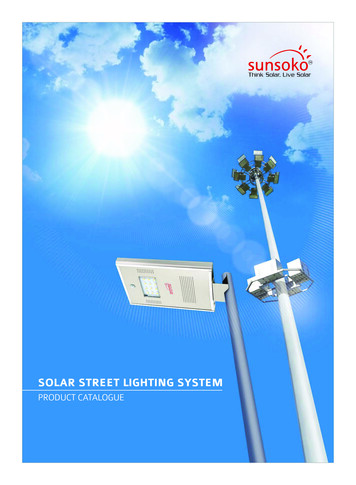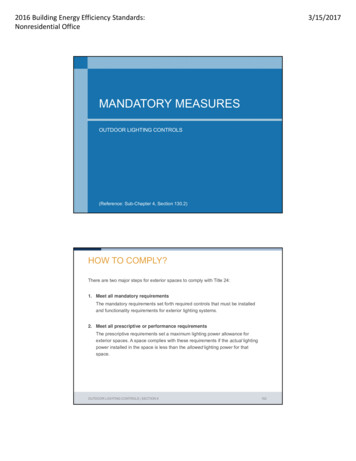
Transcription
2016 Building Energy Efficiency Standards:Nonresidential Office3/15/2017MANDATORY MEASURESOUTDOOR LIGHTING CONTROLS(Reference: Sub-Chapter 4, Section 130.2)OUTDOOR LIGHTING CONTROLS SECTION 6HOW TO COMPLY?There are two major steps for exterior spaces to comply with Title 24:1. Meet all mandatory requirementsThe mandatory requirements set forth required controls that must be installedand functionality requirements for exterior lighting systems.2. Meet all prescriptive or performance requirementsThe prescriptive requirements set a maximum lighting power allowance forexterior spaces. A space complies with these requirements if the actual lightingpower installed in the space is less than the allowed lighting power for thatspace.OUTDOOR LIGHTING CONTROLS SECTION 6152
2016 Building Energy Efficiency Standards:Nonresidential Office3/15/2017Additions and AlterationsOver 50% replaced Mandatory Controls§130.0, 130.2, 130.4 Prescriptive RequirementsLPD allowances of §140.7(Or meet reduced power requirement!)10 50% replaced Mandatory ControlsOr 5 luminaires §130.0, 130.2, 130.4whichever is greater0 10% replaced No measures requiredAny alteration that increases the connected lighting load must meet allmandatory and prescriptive measures that are required.Local government agencies may adopt and enforce energy standards for newly constructed buildings,additions, alterations, and repairs that exceed those of Title 24, Part 6, provided that the EnergyCommission has reviewed and approved the local standards.Section 141.0 (b)2LOUTDOOR LIGHTING CONTROLS SECTION 6153BACKLIGHT, UPLIGHT, AND GLARE RATINGSThe BUG system is used to evaluate luminaire performance in relation to lighting trespass, skyglow, and high-angle brightness. This is necessary in order to reduce light pollution, which has anegative effect on people, wildlife and the surrounding environments.BacklightBacklight includes all illumination that is in the space between the ground and 80 degrees aboveground. Backlighting causes light trespass, which occurs when light is cast in unwanted areas dueto poor control.UplightUplight is defined as excess lighting directed into the night sky. This causes light pollution, alsoknown as artificial sky glow.GlareGlare is any overlapping light between the uplight and backlight zones. It can be mildly offensive orhazardous and visually disabling.Section 130.2 (b)OUTDOOR LIGHTING CONTROLS SECTION 6154
2016 Building Energy Efficiency Standards:Nonresidential Office3/15/2017LUMINAIRES THAT MUST COMPLY WITHBUG REQUIREMENTSOutdoor luminaires using lamps or light sources rated greater than 150 watts must complywith uplight and glare limitations if they are in the following areas:1.Parking lots and service stations2.Building entrances3.All canopies4.Outdoor dining areas5.All outdoor sales areasSection 130.2 (b)OUTDOOR LIGHTING CONTROLS SECTION 6155LUMINAIRES THAT DO NOT NEED TOCOMPLY WITH BUGThese limits do not apply to: Signs Building facades, public monuments, statues, and vertical surfaces of bridges Lighting required for health or safety Temporary lighting Replacement of pole-mounted luminaires in areas where all of the followingapply:1.2.3.4.Connected lighting power is not increasedNo new wiring is being installedNo additional poles are being addedSpacing between poles is greater than six times themounting height of the existing luminairesSection 130.2 (b)OUTDOOR LIGHTING CONTROLS SECTION 6156
2016 Building Energy Efficiency Standards:Nonresidential Office3/15/2017BUG RATINGS AND REQUIREMENTSBUG ratings are determined by the amount of light in each angular component perbacklight, uplight, and glare. Each BUG zone has a maximum number of lumens thatis allowed—called the maximum zonal lumen limit.A list of BUG ratings and tables can be found on the IES UGRatingsAddendum.pdf.Section 130.2 (b)OUTDOOR LIGHTING CONTROLS SECTION 6157BUG RATINGS AND REQUIREMENTSSection 130.2 (b)OUTDOOR LIGHTING CONTROLS SECTION 6158
2016 Building Energy Efficiency Standards:Nonresidential Office3/15/2017Section 130.2 (b)OUTDOOR LIGHTING CONTROLS SECTION 6159ALL OUTDOOR SPACES1. Any outdoor luminaire that is capableof operating an incandescent lampthat uses more than 100 watts mustbe controlled by a motion sensor.2. All outdoor lighting must becontrolled by a photocontrol orastronomical time switch that turnsoff all lighting when daylight isavailable.3. Outdoor lighting must be controlledindependently from other electricalloads.Photo: PhilipsSection 130.2 (a,c)OUTDOOR LIGHTING CONTROLS SECTION 6160
2016 Building Energy Efficiency Standards:Nonresidential Office3/15/2017LUMINAIRES MOUNTED 24’ AND BELOWWhere the bottom of a luminaire is mounted at 24 feet above the ground or lower, thefollowing automatic lighting controls are required:1. A motion sensor or other control system that automatically reduces lighting powerwhen no occupants are detected—at least 40%, but not more than 90%2. Controls must automatically turn on lights when an area becomes occupied3. No more than 1,500 watts of lighting power may be controlled togetherThe following luminaires are exempt:1. Pole-mounted luminaires with a maximum rated power of 75 watts2. Non-pole-mounted luminaires with a maximum rated power of 30 watts3. Linear lighting with a maximum power of 4 watts per linear footSection 130.2 (c)OUTDOOR LIGHTING CONTROLS SECTION 6161LUMINAIRES MOUNTED 24’ AND BELOWThese requirements do not apply to the following spaces:1. Building facades, ornamental hardscape, and outdoor dining areas2. Sales frontage, lots, and canopies3. Any area listed in Section 140.7(a)Section 130.2 (c)OUTDOOR LIGHTING CONTROLS SECTION 6162
2016 Building Energy Efficiency Standards:Nonresidential Office3/15/2017LUMINAIRES MOUNTED 24’ AND BELOWThere are different requirements for specific spaces:1. Sales frontage, lots, and canopies must have a part-night control or motionsensors with auto-on capability2. Building facades, ornamental hardscapes, and outdoor dining must have apart-night control, motion sensor, or centralized time-based lighting controlA part-night control is a time or occupancy based lighting control that isprogrammed to reduce or turn off the lighting power to an outdoor luminaire fora portion of the night.Photo: WattStopperSection 130.2 (c)OUTDOOR LIGHTING CONTROLS SECTION 6163OUTDOOR LIGHTING CONTROLS SECTION 6164
2016 Building Energy Efficiency Standards:Nonresidential Office3/15/20172016 Outdoor LightingRetrofits: If housing stays intact and lighting technology is changed repair. Replacing fixture head alteration.Alteration: 10% moved, changed, replaced fixtures: OR 5 or more fixtures per site (which ever is greater)Adding to connectedNEW ReducingAltering 10-50%load ORRequirementsinstalled wattage byfixtures on siteAltering 50%40% methodfixtures on siteNoNoYesIncandescent 100 w controlled by motionsensor: §130.2(a)YesYesYesLuminaries 150 w to provide cut-off (BUG):§130.2(b)YesPhotocontrol/astronomical time clock: §130.2(c)1YesControl separately from other electrical loads:§130.2(c)2YesMeet lighting power allowances: §140.7Motion Sensor if within 24 ft of ground:§130.2(c)3Part night OR motion sensor for Sales Frontage:§130.2(c)4Part night OR motion sensor OR time-based forfaçade, ornamental, dining: §130.2(c)5YesYesYesFor altered fixtures onlyYesFor altered fixtures onlyYesFor altered fixtures onlyYesFor altered fixtures onlyYesFor altered fixtures onlyYesFor altered fixtures onlyYesFor altered fixtures onlyYesYesYesYesYesYesAcceptance test technician required when any number of controls for 20 fixtures being added for projectOUTDOOR LIGHTING CONTROLS SECTION 6165NRCC-LTO-01-E: Overview of ComplianceOUTDOOR LIGHTING CONTROLS SECTION 6166
2016 Building Energy Efficiency Standards:Nonresidential Office3/15/2017NRCC-LTO-02-E: ControlsOUTDOOR LIGHTING CONTROLS SECTION 6167
Mar 14, 2017 · OUTDOOR LIGHTING CONTROLS SECTION 6 ALL OUTDOOR SPACES 1. Any outdoor luminaire that is capable of operating an incandescent lamp that uses more than 100 watts must be controlled by a motion sensor. 2. All outdoor lighting must be controlled by a photocontrol or astronomical time switch that turns off all



